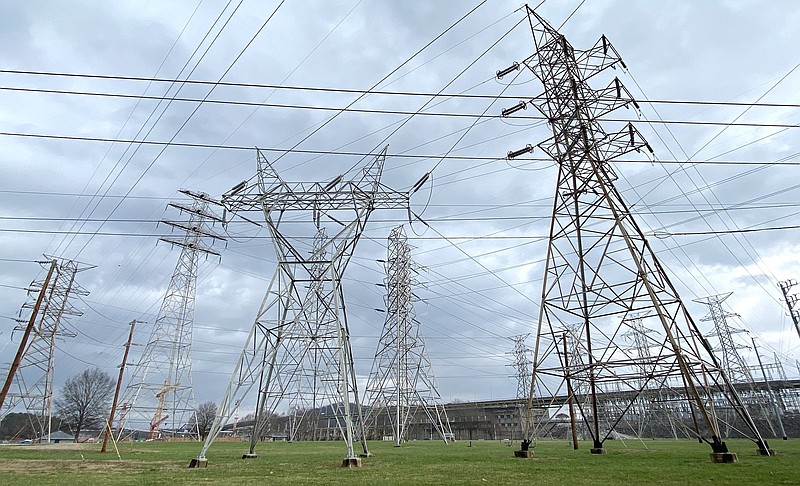The coldest winter storm in the Tennessee Valley in nearly three decades just before Christmas this past year froze instrument lines for 38 of TVA's power generators, cutting off 6,700 megawatts of power and forcing TVA to impose rolling blackouts for the first time in its 90-year history.
Although Winter Storm Elliott proved to be more prolonged and with more rain and wind than originally forecast, a new internal study of the power outages by the federal utility concludes that the cold temperatures "did not take TVA by surprise." But the study said the length and intensity of the storm exceeded the design capabilities of the instruments and lines used to control many of TVA's coal and natural gas-fired plants, leaving TVA without power from its biggest coal plant and more than a dozen of its gas generators.
To avoid a repeat, the utility made more than 250 equipment improvements in January to ensure instrumentation to the Cumberland Fossil Plant and other power plants would work effectively, even in sub-zero temperatures. A new assessment of the winter storm released by TVA on Friday also indicates TVA is upgrading its weather standards for its equipment in the future and is preparing to spend $12 billion over the next four years to expand new generation and replace aging coal plants with more natural gas, solar, hydro and nuclear generation.
"We've changed our design standards for the future based upon our experiences with Winter Storm Elliott to have a more robust approach to deal with extreme weather," James R. "Bob" Dalrymple, senior vice president of coal and gas operations, said in an interview.
COSTLY STORM
Winter Storm Elliott left most of the 10 million Tennessee Valley residents in the dark or cold, at least temporarily, on one of the coldest days of the year in December. But the power outages were more than an inconvenience on Dec. 23 and Christmas Eve. The TVA study estimates the financial impact of the two-day storm totaled $170 million from increased fuel and purchased power costs, repair expenses, lost revenues and investments made to temporarily harden equipment lines.
Those costs pushed up the typical residential power bill for TVA customers by $5.20 in February, TVA said.
Document
Because the power outages came just before Christmas, when schools were closed and many factories were already idled, the business and other social costs of the outages were not as great as they might have been had such a winter storm struck during a typical weekday.
Because the winter storm was so widespread across much of the eastern half of the U.S. just before Christmas, however, TVA was unable to buy or get delivery of purchased power normally used to substitute for its power plants when they shut down.
"TVA anticipated and prepared for this event, but the storm's speed and intensity exceeded forecasts and TVA's efforts," TVA's internal review of the outages concluded. "These conditions increased energy demand beyond what had been forecast, resulting in the highest 24-hour electricity demand supplied in TVA history on Dec. 23 as the speed, intensity, scale and duration of Winter Storm Elliott exceeded the design basis for some of TVA's power plants."
RECORD WINTER PEAK
TVA's system average temperature was 3 degrees at 8 a.m. CDT on Dec. 23. This was the coldest system average temperature since Feb. 5, 1996.
The afternoon high Dec. 23 reached 11 degrees, falling back into single digits that night and Dec. 24. There have not been such back-to-back mornings with system temperature lows in the single digits since February 1996, TVA said.
TVA Chief Operating Officer Don Moul, who helped lead the assessment of the Dec. 23-24 outages, said TVA workers were able to restore power, at least temporarily, from 14 of the plants that were cut off from power delivery because of frozen instrument lines. But the widespread nature of Winter Storm Elliott left many utilities across the Southeast with inadequate power to meet the demand.
"Because of the large scope of this event, the market for power in other regions was also impacted, and many were also forced to make power interruptions or curtail some power deliveries," Moul said.  Staff Photo by Matt Hamilton / Don Moul speaks during a meeting at TVA Headquarters June 7.
Staff Photo by Matt Hamilton / Don Moul speaks during a meeting at TVA Headquarters June 7.
Nearly 1 of every 6 generators suffered problems from Winter Storm Elliott. The biggest power loss came from the inability to maintain 2,500 megawatts of power generation from the Cumberland plant when instrument lines froze for the first time. Such equipment had previously handled polar vortexes and even colder temperatures for short periods. But the speed and intensity of the temperature drop and the winds and rains that caused the flash freezing from Winter Storm Elliott were really unprecedented, Moul said.
Temperatures Dec. 23 plunged by more than 40 degrees in five hours, and winds exceeded 40 mph at some periods during the winter storm, causing flash freezing.
"That combination proved to be above and beyond what some of our plant equipment was designed for," Moul said.
Dalrymple said TVA's seven nuclear reactors and 29 power-generating hydro units at its dams all maintained power production during Winter Storm Elliott, "and they all performed outstandingly well."
The first day, Dec. 23, was really about the resiliency of TVA generation and the fact that the 38 units could not withstand the weather conditions, Dalrymple said.
TVA went into the storm with projected power reserves over the expected demand of more than 3,150 megawatts, but TVA ended up losing more than twice its reserve level when frozen lines cut of power from more than 16% of TVA's generators.
TVA has since improved insulation and protection for the plant instruments and equipment to ensure they will keep running in subzero temperatures or in hot summertime temperatures, Moul said.
"We have not adjusted our reserve margins, but we are going to get our plants to run more reliably in these kind of extreme events," Moul said.
FOSSIL FAILURE?
Environmental groups critical of TVA's continued reliance on coal and natural gas have cited the winter storm as an example of why TVA should move away from fossil fuels that emit carbon dioxide linked with global warming.
Southern Environmental Law Center attorney Amanda Garcia was quoted in Sierra magazine in February saying the blackouts were "caused by failures at the federal utility's gas and coal plants," and she criticized TVA for still "recklessly choosing to double down on new gas plants and pipelines, making the utility even more reliant on fossil fuel technology of the past."
In the same Sierra article, Tennessee state Rep. Justin Pearson, D-Memphis, questioned TVA's decision to build more natural gas generation to replace shuttered coal plants.
"We know the failure of infrastructure is a problem," Pearson said. "We don't need to be building new infrastructure like gas plants but renewables like solar power and other forms that are accessible to us."
But Moul said the power failures for TVA in December stemmed largely from frozen instrumentation, not the type of power generation.
"Every type of generation brings some strengths and some weaknesses," Moul said.
In Winter Storm Uri, in Texas in 2021, wind and solar didn't deliver because it was a freezing rain event, he said.
"So there is not any one answer that is going to be perfect, and that is the value of a diverse power portfolio," Moul said.
REGIONAL IMPACT
The other problem for TVA from Winter Storm Elliott was its widespread impact that limited the availability of purchased power in most of the eastern half of the country. Moul said TVA is working to improve its interconnections with other suppliers, its demand-response and energy efficiency programs to limit peak power demands.
On day two, Dec. 24, TVA had made market purchases to replace that lost generation, but as the utility went through the day and the storm's breadth and depth grew, the market around TVA where it had made those purchases recalled the promised power delivery, so TVA ended up again in a deficient position, Moul said.
The storm also challenged neighboring utilities last December, limiting power availability at PJM, Duke and Southern utilities, among others.
Moul also said TVA is working to improve its communications and connections with the 153 local power companies that distribute TVA across its seven-state region.
"Slow internal coordination and approvals resulted in delayed information-sharing, social media updates and responses to customers," the TVA study said.
TVA's assessment was reviewed by a six-member customer panel that included EPB President David Wade and Tennessee Valley Public Power Association President Doug Peters. The customer group said in a statement that TVA "has been responsive to the questions and concerns" raised by industry and local power companies that were forced to limit operations on Dec. 23 and Dec. 24.
"We believe that TVA is better prepared to address extreme weather events going forward and look forward to seeing more of these recommendations implemented to ensure we continue to get better at serving our customers together," the customer group said in a statement accompanying the TVA study.
Contact Dave Flessner at dflessner@timesfreepress.com or 423-757-6340.
